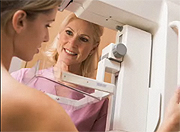Biopsy frequency up after diagnostic, but not screening, mammography
WEDNESDAY, Jan. 28, 2015 (HealthDay News) — For women undergoing screening mammography, there has been an increase in the percentage of biopsies with diagnoses of invasive carcinoma and ductal carcinoma in situ (DCIS), according to a study published online Jan. 20 in Cancer.
Kimberly H. Allison, M.D., from the Stanford University School of Medicine in California, and colleagues examined trends in diagnoses in biopsies by time and risk factors for screening and diagnostic mammography. Data from the Breast Cancer Surveillance Consortium on 4,020,140 mammograms between 1996 and 2008 were linked to 76,567 pathology specimens.
Overall, 88.5 percent of the total mammograms were screening and 11.5 percent were diagnostic; 1.2 and 6.8 percent, respectively, were followed by biopsies. The researchers found that the frequency of biopsies after screening mammograms was stable over time, while there was an increase in the frequency of biopsies after diagnostic mammograms. For biopsies obtained after screening, over time there were increases in the frequencies of invasive carcinoma for women aged 40 to 49 and 60 to 69 years, increases in DCIS for those aged 40 to 69 years, and decreases in benign diagnoses for all ages. Following diagnostic mammograms, there were no trends in pathology diagnoses. Compared with nondense breast tissue, dense breast tissue correlated with high-risk lesions and DCIS.
“Although the frequency of breast biopsy after screening mammography has not changed over time, the percentages of biopsies with DCIS and invasive cancer diagnoses have increased,” the authors write.
Abstract
Full Text (subscription or payment may be required)
Copyright © 2015 HealthDay. All rights reserved.








